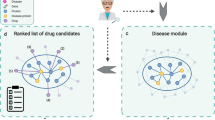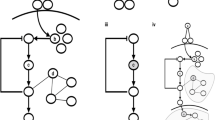Abstract
The large-scale generation and integration of genomic, proteomic, signalling and metabolomic data are increasingly allowing the construction of complex networks that provide a new framework for understanding the molecular basis of physiological or pathophysiological states. Network-based drug discovery aims to harness this knowledge to investigate and understand the impact of interventions, such as candidate drugs, on the molecular networks that define these states. In this article, we describe how such an approach offers a novel way to understand biology, characterize disease and ultimately develop improved therapies, and discuss the challenges to realizing these goals.
This is a preview of subscription content, access via your institution
Access options
Subscribe to this journal
Receive 12 print issues and online access
$209.00 per year
only $17.42 per issue
Buy this article
- Purchase on Springer Link
- Instant access to full article PDF
Prices may be subject to local taxes which are calculated during checkout




Similar content being viewed by others
References
Kola, I. & Landis, J. Can the pharmaceutical industry reduce attrition rates? Nature Rev. Drug Discov. 3, 711–715 (2004).
Barabasi, A. L. & Oltvai, Z. N. Network biology: understanding the cell's functional organization. Nature Rev. Genet. 5, 101–113 (2004).
Bystrykh, L. et al. Uncovering regulatory pathways that affect hematopoietic stem cell function using 'genetical genomics'. Nature Genet. 37, 225–232 (2005).
Chen, Y. et al. Variations in DNA elucidate molecular networks that cause disease. Nature 452, 429–435 (2008).
Emilsson, V. et al. Genetics of gene expression and its effect on disease. Nature 452, 423–428 (2008).
Ghazalpour, A. et al. Genomic analysis of metabolic pathway gene expression in mice. Genome Biol. 6, R59 (2005).
Ideker, T., Ozier, O., Schwikowski, B. & Siegel, A. F. Discovering regulatory and signalling circuits in molecular interaction networks. Bioinformatics 18 (Suppl. 1), 233–240 (2002).
Lum, P. Y. et al. Elucidating the murine brain transcriptional network in a segregating mouse population to identify core functional modules for obesity and diabetes. J. Neurochem. 97 (Suppl. 1), 50–62 (2006).
Schadt, E. E. et al. An integrative genomics approach to infer causal associations between gene expression and disease. Nature Genet. 37, 710–717 (2005).
Schadt, E. E. et al. Genetics of gene expression surveyed in maize, mouse and man. Nature 422, 297–302 (2003).
van 't Veer, L. J. et al. Gene expression profiling predicts clinical outcome of breast cancer. Nature 415, 530–536 (2002).
Wang, S. et al. Genetic and genomic analysis of a fat mass trait with complex inheritance reveals marked sex specificity. PLoS Genet. 2, e15 (2006).
Zhu, J. et al. Integrating large-scale functional genomic data to dissect the complexity of yeast regulatory networks. Nature Genet. 40, 854–861 (2008).
Mehrabian, M. et al. Integrating genotypic and expression data in a segregating mouse population to identify 5-lipoxygenase as a susceptibility gene for obesity and bone traits. Nature Genet. 37, 1224–1233 (2005).
The Wellcome Trust Case Control Consortium. Genome-wide association study of 14,000 cases of seven common diseases and 3,000 shared controls. Nature 447, 661–678 (2007).
Frayling, T. M. Genome-wide association studies provide new insights into type 2 diabetes aetiology. Nature Rev. Genet. 8, 657–662 (2007).
Zeggini, E. et al. Meta-analysis of genome-wide association data and large-scale replication identifies additional susceptibility loci for type 2 diabetes. Nature Genet. 40, 638–645 (2008).
Samani, N. J. et al. Genomewide association analysis of coronary artery disease. N. Engl. J. Med. 357, 443–453 (2007).
Todd, J. A. et al. Robust associations of four new chromosome regions from genome-wide analyses of type 1 diabetes. Nature Genet. 39, 857–864 (2007).
Cancer Genome Atlas Research Network. Comprehensive genomic characterization defines human glioblastoma genes and core pathways. Nature 455, 1061–1068 (2008).
Parsons, D. W. et al. An integrated genomic analysis of human glioblastoma multiforme. Science 321, 1807–1812 (2008).
Shaywitz, D. A. & Taleb, N. N. Drug research needs serendipity. The Financial Times (Lond.) (29 Jul 2008).
Lamb, J. et al. The Connectivity Map: using gene-expression signatures to connect small molecules, genes, and disease. Science 313, 1929–1935 (2006).
Shaywitz, D. A. Science is leading us to more answers, but it's also misleading us. The Washington Post (Washington) HE08 (22 Apr 2008).
van de Vijver, M. J. et al. A gene-expression signature as a predictor of survival in breast cancer. N. Engl. J. Med. 347, 1999–2009 (2002).
Altshuler, D., Daly, M. J. & Lander, E. S. Genetic mapping in human disease. Science 322, 881–888 (2008).
Dewan, A. et al. HTRA1 promoter polymorphism in wet age-related macular degeneration. Science 314, 989–992 (2006).
Yang, Z. et al. A variant of the HTRA1 gene increases susceptibility to age-related macular degeneration. Science 314, 992–993 (2006).
Barrett, J. C. et al. Genome-wide association defines more than 30 distinct susceptibility loci for Crohn's disease. Nature Genet. 40, 955–962 (2008).
Fellay, J. et al. A whole-genome association study of major determinants for host control of HIV-1. Science 317, 944–947 (2007).
Chesler, E. J. et al. Complex trait analysis of gene expression uncovers polygenic and pleiotropic networks that modulate nervous system function. Nature Genet. 37, 233–242 (2005).
Monks, S. A. et al. Genetic inheritance of gene expression in human cell lines. Am. J. Hum. Genet. 75, 1094–1105 (2004).
Morley, M. et al. Genetic analysis of genome-wide variation in human gene expression. Nature 430, 743–747 (2004).
Dixon, A. L. et al. A genome-wide association study of global gene expression. Nature Genet. 39, 1202–1207 (2007).
Moffatt, M. F. et al. Genetic variants regulating ORMDL3 expression contribute to the risk of childhood asthma. Nature 448, 470–473 (2007).
Kathiresan, S. et al. Six new loci associated with blood low-density lipoprotein cholesterol, high-density lipoprotein cholesterol or triglycerides in humans. Nature Genet. 40, 189–197 (2008).
Willer, C. J. et al. Newly identified loci that influence lipid concentrations and risk of coronary artery disease. Nature Genet. 40, 161–169 (2008).
Schadt, E. E. et al. Mapping the genetic architecture of gene expression in human liver. PLoS Biol. 6, e107 (2008).
Zhu, J. et al. Increasing the power to detect causal associations by combining genotypic and expression data in segregating populations. PLoS Comput. Biol. 3, e69 (2007).
Anway, M. D., Cupp, A. S., Uzumcu, M. & Skinner, M. K. Epigenetic transgenerational actions of endocrine disruptors and male fertility. Science 308, 1466–1469 (2005).
Anway, M. D., Leathers, C. & Skinner, M. K. Endocrine disruptor vinclozolin induced epigenetic transgenerational adult-onset disease. Endocrinology 147, 5515–5523 (2006).
Chang, H. S., Anway, M. D., Rekow, S. S. & Skinner, M. K. Transgenerational epigenetic imprinting of the male germline by endocrine disruptor exposure during gonadal sex determination. Endocrinology 147, 5524–5541 (2006).
Zhu, J. et al. An integrative genomics approach to the reconstruction of gene networks in segregating populations. Cytogenet. Genome Res. 105, 363–374 (2004).
Zhu, J., Zhang, B. & Schadt, E. E. A systems biology approach to drug discovery. Adv. Genet. 60, 603–635 (2008).
Ghazalpour, A. et al. Integrating genetic and network analysis to characterize genes related to mouse weight. PLoS Genet. 2, e130 (2006).
Keller, M. P. et al. A gene expression network model of type 2 diabetes links cell cycle regulation in islets with diabetes susceptibility. Genome Res. 18, 706–716 (2008).
Fishman, M. C. & Porter, J. A. Pharmaceuticals: a new grammar for drug discovery. Nature 437, 491–493 (2005).
Shaywitz, D. A. & Melton, D. A. The molecular biography of the cell. Cell 120, 729–731 (2005).
Crowley, W. F. Jr & Thier, S. O. The continuing dilemma in clinical investigation and the future of American health care: a system-wide problem requiring collaborative solutions. Acad. Med. 71, 1154–1163 (1996).
Duyk, G. Attrition and translation. Science 302, 603–605 (2003).
Goldstein, J. L. & Brown, M. S. The clinical investigator: bewitched, bothered, and bewildered — but still beloved. J. Clin. Invest. 99, 2803–2812 (1997).
Jobe, P. C. et al. The essential role of integrative biomedical sciences in protecting and contributing to the health and well-being of our nation. Physiologist 37, 79–86 (1994).
Shaywitz, D. A., Martin, J. B. & Ausiello, D. A. Patient-oriented research: principles and new approaches to training. Am. J. Med. 109, 136–140 (2000).
Bakir, F. et al. Discovery and structure–activity relationship studies of indole derivatives as liver X receptor (LXR) agonists. Bioorg. Med. Chem. Lett. 17, 3473–3479 (2007).
Hughes, T. R. et al. Functional discovery via a compendium of expression profiles. Cell 102, 109–126 (2000).
Hieronymus, H. et al. Gene expression signature-based chemical genomic prediction identifies a novel class of HSP90 pathway modulators. Cancer Cell 10, 321–330 (2006).
Fitzgerald, J. B., Schoeberl, B., Nielsen, U. B. & Sorger, P. K. Systems biology and combination therapy in the quest for clinical efficacy. Nature Chem. Biol. 2, 458–466 (2006).
Holthuis, J. C. & Levine, T. P. Lipid traffic: floppy drives and a superhighway. Nature Rev. Mol. Cell Biol. 6, 209–220 (2005).
Hopkins, A. L. Network pharmacology: the next paradigm in drug discovery. Nature Chem. Biol. 4, 682–690 (2008).
Lamb, J. The Connectivity Map: a new tool for biomedical research. Nature Rev. Cancer 7, 54–60 (2007).
Pearl, J. Probabalistic Reasoning in Intelligent Systems: Networks of Plausible Inference 552 (Morgan Kaufmann, San Mateo, California, 1988).
Shaywitz, D. A. & Auseillo, D. A. Can drug giants survive the biomedical revolution? The Wall Street Journal (New York) (8 Feb 2000).
Shaywitz, D. A. & Auseillo, D. A. Back to the future: medicine and our genes. The New York Times (New York) (16 Apr 2000).
Rual, J. F. et al. Towards a proteome-scale map of the human protein–protein interaction network. Nature 437, 1173–1178 (2005).
Kanehisa, M. The KEGG database. Novartis Found. Symp. 247, 91–101; discussion 101–103, 119–128, 244–252 (2002).
Acknowledgements
We are grateful to K. Wagner, A. Shaywitz, J. Shaywitz, and J. Millstein for their careful reading of this manuscript and insightful comments. We thank J. Williams of Merck's Creative Services Department for assistance in generating Fig. 3.
Author information
Authors and Affiliations
Corresponding authors
Ethics declarations
Competing interests
E. Schadt and S. Friend are employees of Merck Inc. & Co., and own publicly traded shares of stock in Merck. D. Shaywitz is an employee of The Boston Consulting Group, an international strategy and general management consulting firm with clients in nearly every major industry, including health care.
Rights and permissions
About this article
Cite this article
Schadt, E., Friend, S. & Shaywitz, D. A network view of disease and compound screening. Nat Rev Drug Discov 8, 286–295 (2009). https://doi.org/10.1038/nrd2826
Issue Date:
DOI: https://doi.org/10.1038/nrd2826
This article is cited by
-
Environmental induced transgenerational inheritance impacts systems epigenetics in disease etiology
Scientific Reports (2022)
-
Data mining in clinical big data: the frequently used databases, steps, and methodological models
Military Medical Research (2021)
-
Artificial intelligence guided discovery of a barrier-protective therapy in inflammatory bowel disease
Nature Communications (2021)
-
Exploring the role of RALYL in Alzheimer’s disease reserve by network-based approaches
Alzheimer's Research & Therapy (2020)
-
LAMP: disease classification derived from layered assessment on modules and pathways in the human gene network
BMC Bioinformatics (2020)



